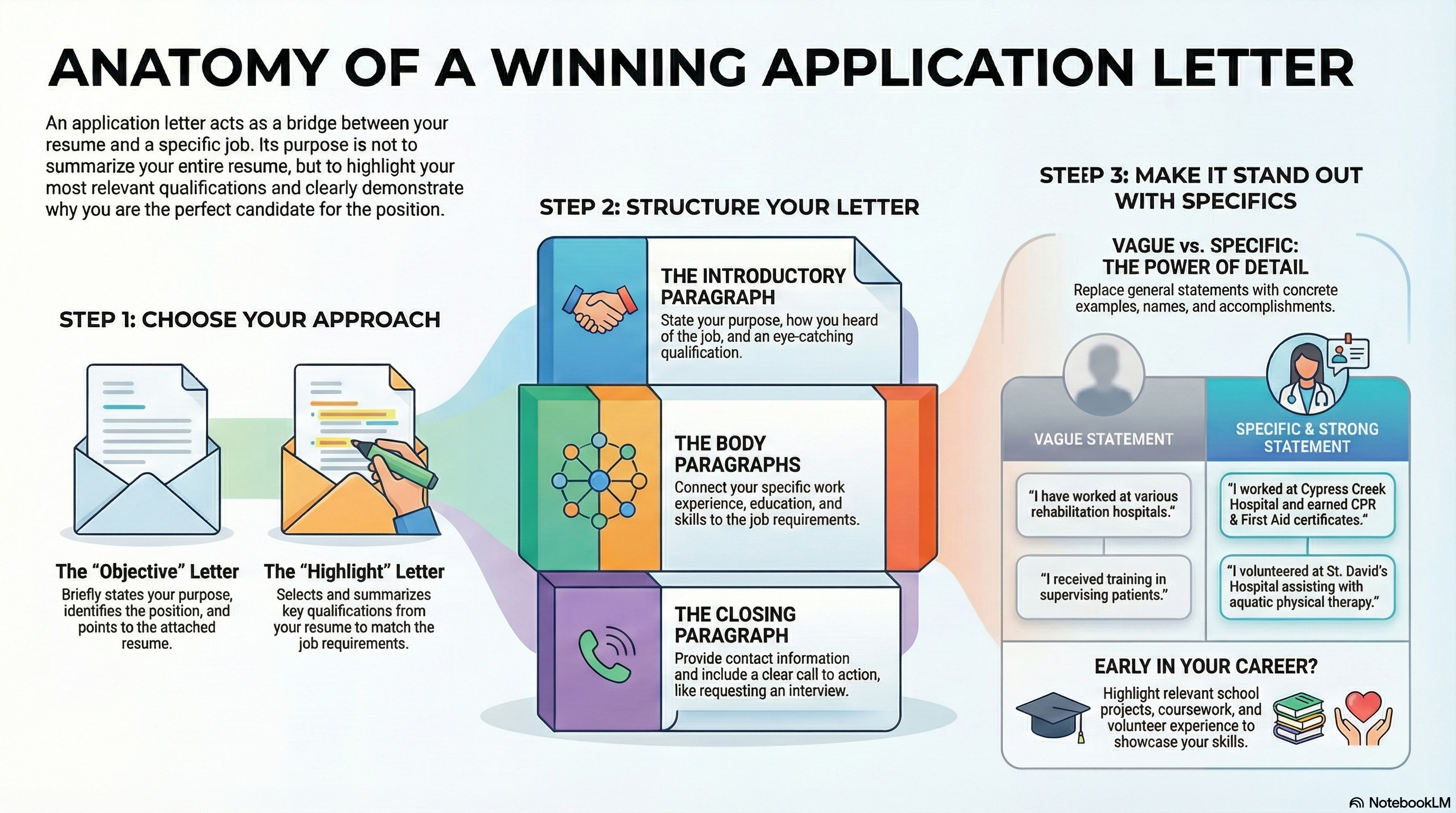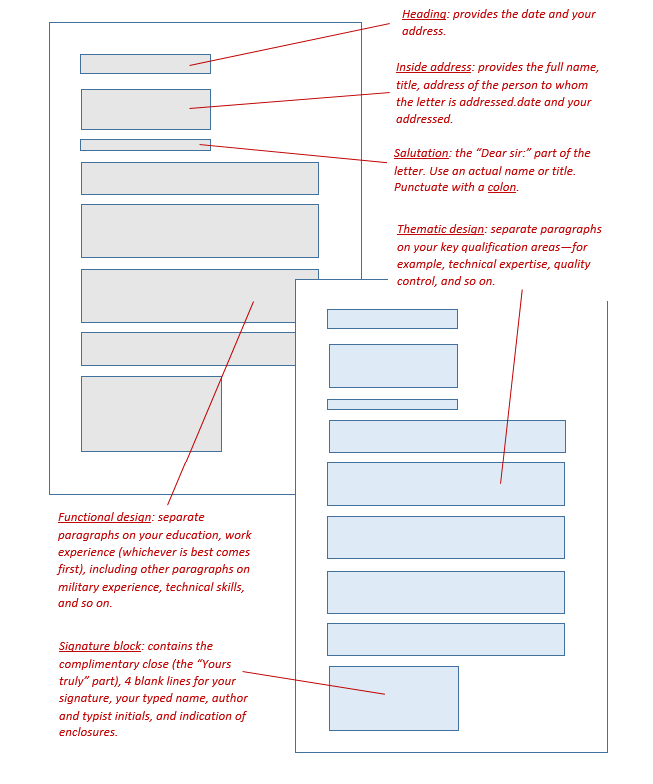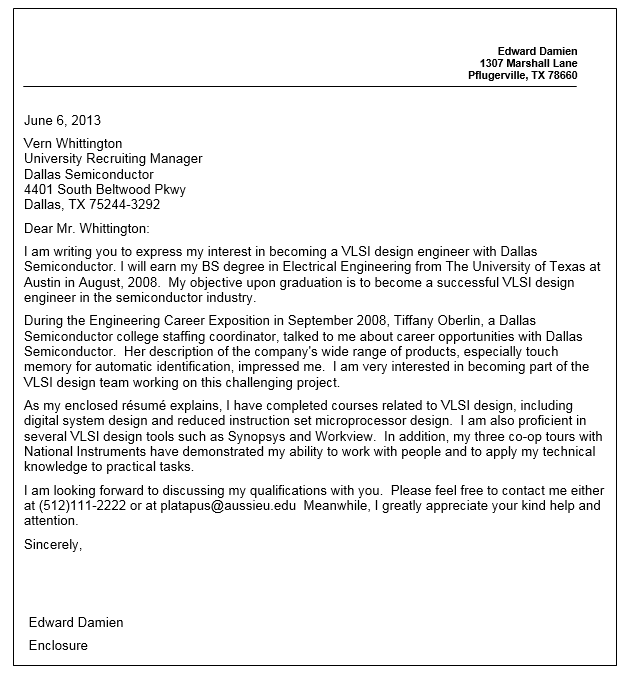Please click here to help David McMurrey pay for web hosting:
Donate any small amount you can !
Online Technical Writing will remain free.
This chapter focuses on the application letter (sometimes called a "cover letter"), which together with the resume is often called the "job package." You may already have written one or both of these employment-seeking documents. That's okay. Read and study this section, and then apply the guidelines here to the resumes and application letters you have created in the past.
In many job applications, you attach an application letter to your resume. Actually, the letter comes before the resume.
The role of the application letter is to draw a clear connection between the job you are seeking and your qualifications listed in the resume. To put it another way, the letter matches the requirements of the job with your qualifications, emphasizing how you are right for that job. The application letter is not a lengthy summary of the resume—not at all. It selectively mentions information in the resume, as appropriate.
Be sure and check out the examples accompanying this chapter.
For related matters:
- See the section on resumes for the companion to this section.
- See the section on general business-letter format and style.
For questions involving justified vs. ragged-right margins:
- Justified vs. Rag Right. fonts.com, n.d.
- Justified Text Versus Ragged-Right Text. Adams Drafting, 2007.
 NotebookLM-generated infographic of this chapter
NotebookLM-generated infographic of this chapter
Common Types of Application Letters
To begin planning your letter, decide which type of application letter you need. This decision is in part based on employers' requirements and, in part, based on what your background and employment needs are. In many ways, types of application letters are like the types of resumes. The types of application letters can be defined according to amount and kind of information:
- Objective letters—One type of letter says very little: it identifies the position being sought, indicates an interest in having an interview, and calls attention to the fact that the resume is attached. It also mentions any other special matters that are not included on the resume, such as dates and times when you are available to come in for an interview. This letter does no salesmanship and is very brief. (It represents the true meaning of "cover" letter.)
- Highlight letters—Another type of application letter, the type you do for most technical writing courses, tries to summarize the key information from the resume, the key information that will emphasize that you are a good candidate for the job. In other words, it selects the best information from the resume and summarizes it in the letter—this type of letter is especially designed to make the connection with the specific job.
How do you know which to write? For most technical-writing courses, write the highlight letter. However, in "real-life" situations, try calling the prospective employer; study the job advertisement for clues.
Common Sections in Application Letters
As for the actual content and organization of the paragraphs within the application letter (specifically for the highlight type of application letter), consider the following comon approaches.
Introductory paragraph. That first paragraph of the application letter is the most important; it sets everything up—the tone, focus, as well as your most important qualification. A typical problem in the introductory paragraph involves diving directly into work and educational experience. Bad idea! A better idea is to do some combination of the following:
- State the purpose of the letter—to inquire about an employment opportunity.
- Indicate the source of your information about the job—newspaper advertisement, a personal contact, or other.
- State one eye-catching, attention-getting thing about yourself in relation to the job or to the employer that will cause the reader to want to continue.
- If possible mention here or in a following paragraph, someone associated with the organization you are applying to who can serve as reference.
And you try to do all things like these in the space of a very short paragraph—no more than 3 to 4 lines of the standard business letter.
Main body paragraphs. In the main parts of the application letter, you present your work experience, military service, education, training—whatever makes that connection between you and the job you are seeking. Remember that this is the most important job you have to do in this letter—to enable the reader see the match between your qualifications and the requirements for the job.
There are two common ways to present this information:
- Functional approach—This one presents education in one section, and work experience in the other. If there were military experience, that might go in another section. Whichever of these section contains your "best stuff" should come first, after the introduction.
- Thematic approach—This one divides experience and education into groups such as "management," "technical," "financial," and so on and then discusses your work and education related to them in separate paragraphs.
If you read the section on functional and thematic organization of resumes, just about everything said there applies here. Of course, the letter is not exhaustive or complete about your background—it highlights just those aspects of your background that make the connection with the job you are seeking.

Common sections of application letters. You can organize the letter thematically or functionally the same way that you can the resume.
Another section worth considering for the main body of the application letter is one in which you discuss your goals, objectives—the focus of your career—what you are doing, or want to do professionally. A paragraph like this is particularly good for people just starting their careers, when there is not much to put in the letter. Of course, be careful about loading a paragraph like this with "sweet nothings." For example, "I am seeking a challenging, rewarding career with a dynamic upscale company where I will have ample room for professional and personal growth"—come on! give us a break! Might as well say, "I want to be happy, well-paid, and well-fed."
Closing paragraph. In the last paragraph of the application letter, you can indicate how the prospective employer can get in touch with you and when are the best times for an interview. This is the place to urge that prospective employer to contact you to arrange an interview.
Specific Details in the Application Letter
One of the best ways to make an application letter great is to work in details, examples, specifics about related aspects of your educational and employment background. Yes, if the resume is attached, readers can see all that details there. However, a letter that is overly general and vague might generate so little interest that the reader might not even care to turn to the resume.
In the application letter, you work in selective detail that makes your letter stand out, makes it memorable, and substantiates the claims you make about your skills and experience. Take a look at this example, which is rather lacking in specifics:
| As for my experience working with persons with developmental disabilities, I have worked and volunteered at various rehabilitation hospitals and agencies in Austin and Houston [say which ones to inject more detail into this letter]. I have received training [where? certificates?] in supervising patients and assisting with physical and social therapy [which specific therapies?]. Currently, I am volunteering at St. David's Hospital [doing what?] to continue my education in aiding persons with developmental disabilities [which specific disabilities?]. |
Now take a look at the revision:
| As for my experience working with persons with developmental disabilities, I have worked and volunteered at Cypress Creek Hospital in Houston and Capital Area Easter Seals/ Rehabilitation Center and Health South Rehabilitation Hospital in Austin. I have received CPR, First Aid, and Crisis Intervention certificates from Cypress Creek Hospital. Currently, I am volunteering at St. David's Hospital assisting with physical therapy to persons with developmental disabilities in the aquatics department. |
Early-Career Application Letters
In the past and in the examples here, you may seen some rather impressive application letters. But what if you don't have all that experience—how do you construct a respectable application letter?
- Cite relevant projects (both in academia and community) you've worked on, even if they are not exactly related to the career that you pursue.
- Spend extra time describing college courses and programs you have been involved in. What about team projects, research projects, or reports?
- Include volunteer work that has had any trace of technical in it. (If you've not done any volunteer work, get to volunteering!)
- List any organizations you have been a member of and describe any of their activities that have any trace of technical in them. (If you've not belonged to any technically oriented organizations, get to belonging!)
- As with the resume, you can use formatting to spread what information you have to fill out the resume page.
In the example student application letter below, notice that the writer describes his coursework and the applications that he used. His reference to a professional exposition shows an active interest in a particular technical area. Moreover, his visit with an employee of the company with which he seeks employment is a crafty form of name dropping. In general, the letter expresses enthusiasm about working in the VLSI area.

Early-career application letter. Use the strategies suggested here to fill your letter with good specific information.
AI Prompts for Application Letters
Checklists, which typically go unread, can be used as source for AI prompts with some modification. Copy the following, paste it into an AI system such as Google's Gemini, and see what you may have missed.
Note: All references to the content, format, style of application letters or their components can be found in the online technical-writing textbook.
|
AI Prompts for Application Letters Hello, AI. I am requesting that you evaluate an application letter written by a U.S. college sophomore. Below is a summary of textbook chapters on general business correspondence and application letters to use as the basis of your evaluation. (Identifying information masked):
|
Related Information
How To Beat The Dreaded Job Application Tracking System
General business correspondence
Common Grammar, Usage, Spelling Problems
I would appreciate your thoughts, reactions, criticism regarding this chapter: your response—David McMurrey.
